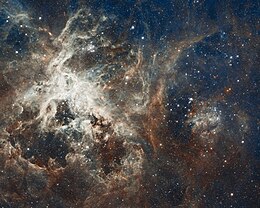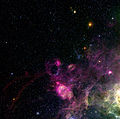타란툴라 성운
Tarantula Nebula| 방출 성운 | |
|---|---|
| HII 영역 | |
 | |
| 관측 데이터: J2000 epoch | |
| 적경 | 05h 38m 38s[1] |
| 적위 | −69° 05.7′[1] |
| 거리 | 160 ± 10 ky (49 ± 3[2][3] k pc) |
| 겉보기 등급(V) | +8[2] |
| 외관 치수(V) | 40° x 25°[2] |
| 콘스텔레이션 | 도라도 |
| 물리적 특성 | |
| 반지름 | 931년형[2][4] |
| 특장점 | LMC 내 |
| 지정 | NGC 2070,[2] 도라두스 [1]성운, 도라두스 성운,[1] 30 도라두스 |
타란툴라 성운(30도라두스)은 대마젤란 구름(LMC)에 있는 거대한 HII 지역으로, 지구의 관점에서 남동쪽 모서리를 형성합니다.
검출
타란툴라 성운은 니콜라 루이 드 라카유가 1751년과 1753년 사이 희망봉 탐험 중에 관측했습니다.그는 그것을 "일류 네불래"의 두 번째 목록으로 작성했다. "두 발 망원경에 보이는 어떤 별도 동반하지 않는 신경성"그것은 [5]지름 20'의 확산 성운으로 묘사되었다.
요한 보데는 타란툴라를 그의 1801년 우라노그래피아 별 지도에 포함시켰고, 동반된 Algemeine Beschreibung und Nachweisung der Gestirne 목록에 Xiphias 또는 Dorado 별자리의 30번으로 등재했다.이 행성은 별의 밝기가 주어지는 대신 모호하다고 [6]지적되었다.
타란툴라 성운이라는 이름은 20세기 중반 깊은 사진 [7]노출로 인해 생겨났다.
30 황새치자리는 종종 [8][9]별 또는 중앙성단 NGC 2070의 [10]명칭으로 취급되어 왔지만, 현재는 일반적으로 타란툴라 [11][12]성운의 전체 성운 영역을 지칭하는 것으로 취급되고 있습니다.
특성.
타란툴라 성운의 겉보기 등급은 8입니다.약 49kpc[2](16만 광년)의 거리를 고려하면 이는 매우 밝은 비성형 천체이다.만약 그것이 오리온 성운만큼 지구에 가까웠다면, 타란툴라 성운은 눈에 보이는 그림자를 [13]던졌을 것입니다.사실, 이것은 국부 은하군에서 가장 활발한 항성폭발 영역입니다.또한 지름이 약 200에서 570pc로 [2][3]국부 그룹에서 가장 큰 H II 영역 중 하나이며, 매우 크기 때문에 때때로 가장 큰 H II 영역으로 묘사되기도 하지만, 삼각형자리 은하에 있는 NGC 604와 같은 다른 H II 영역은 더 [3]클 수 있습니다.성운은 램 압력 박리 및 이로 인한 성간 매질의 압축이 최대인 LMC의 앞쪽 가장자리에 있습니다.
NGC 2070
30 황새치자리 중심에는 R136으로[14] 알려진 별들의 밀집된 집중을 포함하는 성단 NGC 2070이 있으며, 이 성단은 성운을 가시화하는 대부분의 에너지를 생산합니다.이 성단의 추정 질량은 태양 질량이 45만 개에 [15]달해 앞으로 구상 성단이 될 것으로 보인다.타란툴라 성운에는 NGC 2070 외에도 훨씬 오래된 호지 301을 포함한 많은 다른 성단이 포함되어 있습니다.호지 301의 가장 질량이 큰 별들은 이미 초신성으로 [16]폭발했다.
초신성 1987a
망원경의 [17]발명 이후 관측된 초신성 중 가장 가까운 초신성인 초신성 1987A는 타란툴라 [18]성운의 외곽에서 발생했다.산개성단 NGC 2060을 둘러싼 초신성 잔해가 눈에 띄지만, 복잡한 [19]성운에서는 다른 많은 초신성 잔해를 발견하기가 어렵습니다.
블랙홀 VFTS 243
우리은하의 첫 번째 외부인 타란툴라 성운에서 X선 조용한 블랙홀이 발견되었습니다.이 블랙홀은 최소 9 태양 질량의 질량을 가지고 있으며 25 태양 질량의 청색 [20]거성과 함께 원형 궤도에 있다.
이미지 갤러리
타란툴라[21] 성운의 성단, 빛나는 가스 구름 및 초신성 폭발 잔해로 이루어진 우주 풍경
적응광학설비로[22] HOOK-I로 촬영된 타란툴라 성운 영역
대마젤란 구름의 빛나는 별 VFTS 682(학점: ESO 등)
광역 적외선 탐사선(WISE)의 타란툴라 성운
스피처 우주 망원경을 이용한 타란툴라 성운 이미지 2020년 1월
「 」를 참조해 주세요.
레퍼런스
- ^ a b c d "NAME 30 Dor Nebula". SIMBAD. Centre de données astronomiques de Strasbourg. Retrieved 2006-12-22.
- ^ a b c d e f g "Results for Tarantula Nebula". SEDS Students for the Exploration and Development of Space. Retrieved 2007-05-08.
30 Doradus .. 49 kpc +- 3 kpc
- ^ a b c Lebouteiller, V.; Bernard-Salas, J.; Brandl, B.; Whelan, D. G.; et al. (June 2008). "Chemical Composition and Mixing in Giant H II Regions: NGC 3603, 30 Doradus, and N66". The Astrophysical Journal. 680 (1): 398–419. arXiv:0710.4549. Bibcode:2008ApJ...680..398L. doi:10.1086/587503. S2CID 16924851.
- ^ 거리 × sin(직경_각도 / 2) = 반지름 931 ly
- ^ Jones, K. G. (1969). "The search for the nebulae - VI". Journal of the British Astronomical Association. 79: 213. Bibcode:1969JBAA...79..213J.
- ^ Johann Elert Bode (1801). Allgemeine Beschreibung und Nachweisung der Gestirne: Nebst Verzeichniss der geraden Aufsteigung und Abweichung von 17240 Sternen, Doppelsternen, Nebelflecken und Sternhaufen:(zu dessen Uranographie gehörig). Selbstverl. pp. 1–.
- ^ Feast, M. W. (1961). "A Study of the 30 Doradus Region of the Large Magellanic Cloud". Monthly Notices of the Royal Astronomical Society. 122: 1–16. Bibcode:1961MNRAS.122....1F. doi:10.1093/mnras/122.1.1.
- ^ Pickering, E. C.; Fleming, W. P. (1897). "Large Magellanic Cloud". Astrophysical Journal. 6: 459. Bibcode:1897ApJ.....6..459P. doi:10.1086/140426.
- ^ "Notes on some Points connected with the Progress of Astronomy during the past Year". Monthly Notices of the Royal Astronomical Society. 53 (4): 274. 1893. doi:10.1093/mnras/53.4.263.
- ^ Andersen, M.; Zinnecker, H.; Moneti, A.; McCaughrean, M. J.; Brandl, B.; Brandner, W.; Meylan, G.; Hunter, D. (2009). "The Low-Mass Initial Mass Function in the 30 Doradus Starburst Cluster". The Astrophysical Journal. 707 (2): 1347–1360. arXiv:0911.2755. Bibcode:2009ApJ...707.1347A. doi:10.1088/0004-637X/707/2/1347. S2CID 118467387.
- ^ Walborn, N. R. (1984). "The stellar content of 30 Doradus". Structure and Evolution of the Magellanic Clouds. IN: Structure and Evolution of the Magellanic Clouds; Proceedings of the Symposium. Vol. 108. pp. 243–253. Bibcode:1984IAUS..108..243W. doi:10.1007/978-94-010-9801-4_59. ISBN 978-90-277-1723-8.
- ^ Aguirre, J. E.; Bezaire, J. J.; Cheng, E. S.; Cottingham, D. A.; Cordone, S. S.; Crawford, T. M.; Fixsen, D. J.; Knox, L.; Meyer, S. S.; Norgaard‐Nielsen, H. U.; Silverberg, R. F.; Timbie, P.; Wilson, G. W. (2003). "The Spectrum of Integrated Millimeter Flux of the Magellanic Clouds and 30 Doradus from Top Hat and DIRBE Data". The Astrophysical Journal. 596 (1): 273–286. arXiv:astro-ph/0306425. Bibcode:2003ApJ...596..273A. doi:10.1086/377601. S2CID 14291665.
- ^ "National Optical Astronomy Observatory Press Release: NEIGHBOR GALAXY CAUGHT STEALING STARS".
- ^ Massey, P; Hunter, D. (January 1998). "Star Formation in R136: A Cluster of O3 Stars Revealed by Hubble Space Telescope Spectroscopy". The Astrophysical Journal. 493 (1): 180. Bibcode:1998ApJ...493..180M. doi:10.1086/305126.
- ^ Bosch, Guillermo; Terlevich, Elena; Terlevich, Roberto (2009). "Gemini/GMOS Search for Massive Binaries in the Ionizing Cluster of 30 Dor". Astronomical Journal. 137 (2): 3437–3441. arXiv:0811.4748. Bibcode:2009AJ....137.3437B. doi:10.1088/0004-6256/137/2/3437. S2CID 17976455.
- ^ Grebel, Eva K.; Chu, You-Hua (2000). "Hubble Space Telescope Photometry of Hodge 301: An "Old" Star Cluster in 30 Doradus". Astronomical Journal. 119 (2): 787–799. arXiv:astro-ph/9910426. Bibcode:2000AJ....119..787G. doi:10.1086/301218. S2CID 118590210.
- ^ "Tarantula Nebula's Cosmic Web a Thing of Beauty". SPACE.com. 2011-03-21. Retrieved 2011-03-26.
- ^ Couper, Heather; Henbest, Nigel (2009). Encyclopedia of Space. DK Publishing. p. 299. ISBN 978-0-7566-5600-3.
- ^ Lazendic, J. S.; Dickel, J. R.; Jones, P. A. (2003). "Supernova Remnant Candidates in the 30 Doradus Nebula". The Astrophysical Journal. 596 (1): 287. Bibcode:2003ApJ...596..287L. doi:10.1086/377630.
- ^ Shenar, Tomer; et al. (2022). "An X-ray-quiet black hole born with a negligible kick in a massive binary within the Large Magellanic Cloud". Nature Astronomy. arXiv:2207.07675. doi:10.1038/s41550-022-01730-y. S2CID 250626810.
- ^ "A Crowded Neighbourhood". www.eso.org. Retrieved 31 May 2018.
- ^ "Sharper Images for VLT Infrared Camera - Adaptive optics facility extended to HAWK-I instrument". www.eso.org. Retrieved 31 January 2018.
외부 링크
- WikiSky의 타란툴라 성운: DSS2, SDSS, GALEX, IRAS, 수소α, X선, 천체사진, 스카이맵, 기사 및 이미지
- APOD 이미지: 2003년 8월 23일 및 2010년 5월 18일
- SEDS 데이터: NGC 2070, 타란툴라 성운
- 허블 우주 망원경 이미지:타란툴라 성운
- 유럽 남부 천문대 이미지:타란툴라 성운
- 우주의 규모 (2012년 3월 12일 오늘의 천문사진)
- Crowther, Paul. "Tarantula Nebula and Its Huge Stars". Deep Space Videos. Brady Haran.

![Cosmic landscape of star clusters, glowing gas clouds and the scattered remains of supernova explosions in the Tarantula Nebula[21]](http://upload.wikimedia.org/wikipedia/commons/thumb/1/17/The_rich_region_around_the_Tarantula_Nebula_in_the_Large_Magellanic_Cloud.jpg/120px-The_rich_region_around_the_Tarantula_Nebula_in_the_Large_Magellanic_Cloud.jpg)
![Tarantula Nebula region imaged with HAWK-I with the Adaptive Optics Facility[22]](http://upload.wikimedia.org/wikipedia/commons/thumb/a/a0/The_Tarantula_Nebula_region_imaged_with_HAWK-I_with_the_Adaptive_Optics_Facility.jpg/120px-The_Tarantula_Nebula_region_imaged_with_HAWK-I_with_the_Adaptive_Optics_Facility.jpg)












